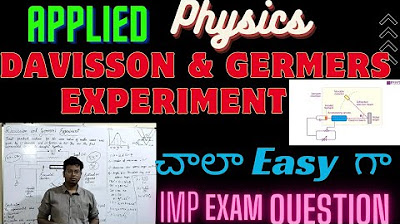Davisson Germer Experiment
Summary
TLDRIn 1927, Davisson and Germer conducted an experiment using a nickel chloride crystal and an electron gun to demonstrate the wave-particle duality of electrons. They observed peak intensities in the scattered electron beam at certain angles, indicative of constructive interference, a wave phenomenon. By plotting a graph of scattering intensity against the angle of incidence and accelerating potential, they confirmed the wave nature of electrons, thus validating de Broglie's hypothesis of matter's dual particle-wave nature.
Takeaways
- 🌌 The Davison-Germer experiment in 1927 was a pivotal study that demonstrated the wave nature of electrons, supporting the de Broglie hypothesis that all matter exhibits both wave and particle characteristics.
- 🔬 The experimental setup included a nickel chloride crystal as the target, an electron gun for producing an electron beam, and a detector to measure the scattered electrons.
- 💡 The electron gun was composed of a heated tungsten filament and high and low tension batteries, with the filament emitting electrons when heated and the high tension battery accelerating the electron beam.
- 🎯 The experiment involved directing the electron beam through a pinhole and onto the crystal, where electrons were scattered in all directions, behaving like waves.
- 📊 At certain angles, the detector recorded peaks in the intensity of the scattered electron beam, indicating constructive interference, a phenomenon exclusive to waves.
- 📉 Davison and Germer plotted a graph with the angle of scattering on the y-axis and the intensity of the scattered beam at different accelerating potentials on the x-axis.
- 🔍 A significant 'bump' or kink in the graph was observed when the angle of scattering was 50°, which intensified with increasing accelerating potential and then decreased, signifying the wave nature of electrons.
- 🌟 The experiment's results were crucial in verifying the wave-particle duality of matter, a fundamental concept in quantum mechanics.
- 📚 The Davison-Germer experiment is a classic example of how scientific experiments can confirm theoretical predictions and expand our understanding of the physical world.
- 🏆 The work of Davison and Germer is commemorated as a milestone in the field of physics, illustrating the importance of experimental validation in scientific discovery.
Q & A
What was the hypothesis proposed by de Broglie in 1924 regarding matter?
-De Broglie postulated that all forms of matter have both wave and particle characteristics, suggesting that electrons, like light, have a dual particle-wave nature.
Who were the two American physicists that experimentally proved the wave nature of material particles?
-CJ Davisson and LH Germer were the two American physicists who first experimentally proved the wave nature of material particles.
What was the key component of the experimental setup used by Davisson and Germer?
-The key components of the experimental setup used by Davisson and Germer were a nickel target, an electron gun, and a detector.
How did the electron gun produce an electron beam in the experiment?
-The electron gun produced an electron beam by heating a Tungsten filament with a low tension battery, which then emitted electrons, and a high tension battery was used to accelerate the electron beam.
What was the purpose of the pinhole in the experimental setup?
-The purpose of the pinhole in the experimental setup was to direct the electron beam to strike the crystal normally.
How did Davisson and Germer observe the wave nature of electrons during the experiment?
-Davisson and Germer observed the wave nature of electrons by noticing that at certain angles, the detector indicated a peak in the intensity of the scattered electron beam, which was due to constructive interference, a phenomenon unique to waves.
What did the graph plotted by Davisson and Germer show in relation to the wave nature of electrons?
-The graph plotted by Davisson and Germer showed that the intensity of scattering depends upon the angle of scattering, and a bump or kink in the curve occurred when the angle was 50°, indicating the wave behavior of electrons.
How did the bump or kink in the curve change as the accelerating potential difference was varied?
-The bump or kink in the curve increased as the accelerating potential difference was increased, reached a maximum at 54 volts, and then decreased on further increase of potential difference.
What was the significance of the experimental results obtained by Davisson and Germer?
-The experimental results obtained by Davisson and Germer were significant as they verified de Broglie's hypothesis of the wave nature of matter particles, providing empirical evidence for the dual particle-wave nature of electrons.
What was the role of the sensitive galvanometer in the experiment?
-The sensitive galvanometer was connected to the detector and played a role in measuring the intensity of the scattered electron beam, which was crucial for observing the wave-like behavior of electrons.
Outlines

Этот раздел доступен только подписчикам платных тарифов. Пожалуйста, перейдите на платный тариф для доступа.
Перейти на платный тарифMindmap

Этот раздел доступен только подписчикам платных тарифов. Пожалуйста, перейдите на платный тариф для доступа.
Перейти на платный тарифKeywords

Этот раздел доступен только подписчикам платных тарифов. Пожалуйста, перейдите на платный тариф для доступа.
Перейти на платный тарифHighlights

Этот раздел доступен только подписчикам платных тарифов. Пожалуйста, перейдите на платный тариф для доступа.
Перейти на платный тарифTranscripts

Этот раздел доступен только подписчикам платных тарифов. Пожалуйста, перейдите на платный тариф для доступа.
Перейти на платный тарифПосмотреть больше похожих видео

BTECH PHYSICS | DAVISSON GERMER EXPERIMENT |APPLIED PHYSICS|DUAL NATURE of Radiation Telugu #btech

Davisson-Germer Experiment & Wave-Particle Duality

The de Broglie Wavelength and Wave Particle Duality - A Level Physics

Knocking Electrons With Light—The Photoelectric Effect

The Double-Slit Experiment

Dr Quantum Double Slit Experiment
5.0 / 5 (0 votes)
